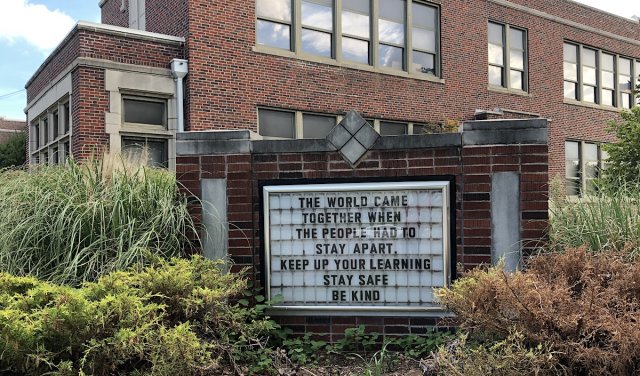
(Update: On Tuesday, July 21, the Oklahoma City Public Schools Board voted to delay the start of the academic year from Aug. 10 to Aud. 31 and begin with virtual instruction only for the first nine weeks.)
The Oklahoma City Public Schools’ “Roadmap to Readiness” is a good blueprint for reopening schools. It is consistent with the leaked 69-page Center for Disease Control analysis that the Trump administration refused to release, which also described school reopenings as the “highest risk” for coronavirus spread.
However, President Donald Trump pushes forward, saying, “We’re very much going to put pressure on governors and everybody else to open the schools.”
That’s one of three reasons why OKCPS’ “Roadmap to Readiness” should be subtitled, “Minimizing the Harm This Year.” As Oklahoma’s largest school district creeps toward a potential return to the classroom this fall, governmental policies will determine whether schools can limit the inevitable damage.
Looking at all models, ‘none of them are great’
To understand what it would take to safely reopen schools, we should recall the third week of May. After studying published CDC recommendations, OKCPS Superintendent Sean McDaniel addressed the balancing of in-school instruction and virtual learning.
“We looked and talked about all the models,” McDaniel said. “None of them are great, and every one of them is going to cause a level of alarm.”
Two months ago, such honesty wasn’t the only thing the OKCPS had going for it. Oklahoma City was doing an excellent job combating COVID-19, following the outstanding leadership of Mayor David Holt and medical experts. As Eric Pennell explained for NonDoc, the state’s infection rate then had a “nice dip in the last days of May.” But that was before Gov. Kevin Stitt’s Open Up and Recover Safely plan had entered Phase III. During June, the rolling average of daily infections increased by more than 800 percent from 92 to 721. Now, we have seen more than a 10-fold increase in Oklahoma City’s active cases.
Since then, a variety of experts have presented a persuasive case for reopening schools this fall. The failure to provide in-person instruction will undermine the economic recovery, damage children’s mental health — as well as educational growth — and widen the opportunity gap between affluent kids and poor children of color. Unfortunately, many education experts have presented an equally strong case that it will be impossible to reopen schools in many places.
This dilemma is explained in the New York Times’ We Have to Focus on Opening Schools, Not Bars, by Jennifer Nuzzo, an epidemiologist, and Joshua Sharfstein, a pediatrician. When making the economic and public health case for reopening schools, they argue, “Reopening businesses that pose a major risk of community spread should be a lower priority than reopening schools, for which continued closure carries far greater harm.”
Nuzzo’s and Sharfstein’s recommendations are consistent with most of the OKCPS’ plan, but they also call for schools to do things that would be impossible.
“Young children, in particular, may require in-person instruction and socialization. Special-needs students need services provided by schools in person,” they write.
They also recommend that at-risk teachers and students be allowed to opt out of in-person instruction, and they urge refinement of online instruction. In case schools need to be shut down, districts must “be prepared by using curriculums that can be rapidly adapted for online instruction.”
However, Nuzzo and Sharfstein say school districts should “get creative” with transportation, perhaps rent additional space so “bubbles” of students can remain separate, and adopt “strict requirements for masks.” It’s hard to visualize the OKCPS fully implementing those measures.
Nuzzo’s and Sharfstein’s argument applies to Oklahoma City: “Officials let bars, restaurants and gyms open, despite warnings from public health experts that these environments pose the greatest risk for spreading the disease.”
They thus nail the reason why OKCPS will have little power for minimizing harm for students. When the premature reopening of Oklahoma City’s economy was prioritized, we followed the path described by educator Carol Burris.
“Children have been the silent victims of this pandemic,” Burris writes. “They have been subjected to harm, in part, by irresponsible adults who have refused to do what it takes to put the virus in check.”
Low-income students could struggle
Second, as we consider how this fall’s return to school may play out, it’s important to recognize that the online learning that intertwined with every OKCPS scenario has been a spectacular failure around the country during the pandemic. Eventually, virtual learning will become a constructive tool, but it seems like that will take a long time.
As the New York Times reports, last spring’s shift to remote learning “wiped out academic gains for many students in America, and widened racial and economic gaps.” A huge study by researchers at Brown and Harvard found that “student progress in math decreased by about half in classrooms located in low-income ZIP codes, by a third in classrooms in middle-income ZIP codes and not at all in classrooms in high-income ZIP codes.” A study of online learning and other impacts found that “the average student could fall seven months behind academically, while black and Hispanic students could experience even greater learning losses, equivalent to 10 months for black children and nine months for Latinos.”
Unfortunately, unless schools can reopen long enough to establish constructive school cultures, this year’s online outcomes could be worse. The American Economic Institute’s Rick Hess and Nat Malkus remind us that the key to education success is building relationships. Last year, online instruction had a “massive advantage” of being started in the spring. Hess and Malkus noted.
“Most students had been seeing the same teachers and classmates nearly every weekday since September,” they said. “This head start will be gone come fall.”
Finally, the OKCPS will need to answer an inevitable question for parents: “What if my student gets sick or someone in the home is positive?”
As long as Oklahomans are more focused on bars than contact tracing, our community will not make it easy for OKCPS to answer these questions.






















